#beaver dam
Text
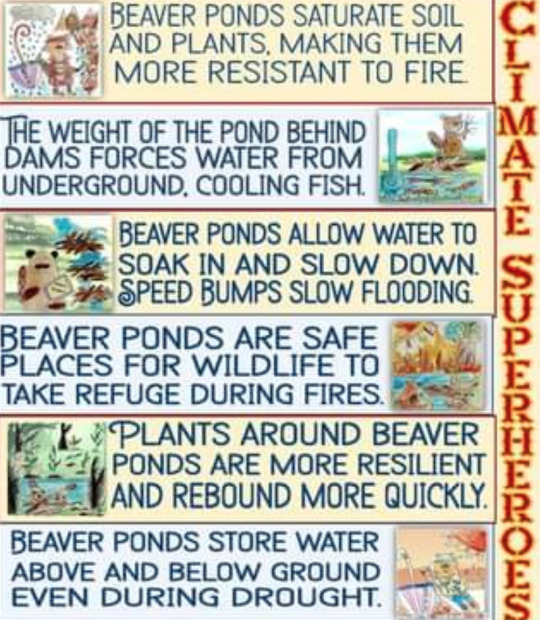
397 notes
·
View notes
Text
Wet Beast Wednesday: beavers
I love rodents; they're my favorite mammals. So today I'm combining rodents with the usual Wet Beast Wednesday to talk about beavers. These rodents are not only amphibious, they're engineers that play a major role in their ecosystems. Let's find out why you should appreciate beavers.

(Image ID: a beaver standing on dirt. It is a rotund, furry mammal with a large, blunt head. Its legs and eyes are small. Its tail is wide, flat, and hairless. It is wet. End ID)
There are two species of beaver: the North American beaver Castor canadensis and Eurasian beaver Castor fiber. The two species are so similar to each other in morphology and behavior that it took genetic testing to confirm that they are distinct species. Each species is divided into many subspecies, with a classified 25 for the North American beaver and 9 for the Eurasian beaver. Beavers are the second largest living rodents after the capybara. Adults have a body length of 80-120 cm (31-47 in), tail length of 25-50 cm (9.8-19.7 in) and usually weigh between 11 and 30 kg (24-66 lbs) but can reach up to 50 kg (110 lbs). Beavers are semiaquatic and have multiple adaptations for living in the water. The hind legs have webbed toes and are used to provide propulsion while swimming. The wide, flat, paddle-like tail is used as a rudder. Beaver fur is very thick, with 12,000 to 23,000 hairs per square centimeter and grows in multiple layers. The hair keeps the beaver warm and provides buoyancy while being thick enough to act as armor, protecting the beaver from predators. Beavers can hold their breath for up to 15 minutes, but most dives are shorter than that. While underwater, the beaver's heart rate is halved and blood is redirected to the brain and away from the extremities. The ears and nostrils can close underwater and the mouth can form a watertight seal. Being highly adapted for swimming, beavers are somewhat clumsy on land, but they can still move fast if needed. The front feet are very dextrous and can carry objects. Beavers can stand and move on their hind legs while holding things with their front feet. The tail helps provide stability while standing up. Like other rodents, beavers have an upper and lower pair of incisors that grow for their entire lives. The teeth need to be worn down by gnawing on objects and a beaver that can't gnaw can suffer from health problems as their incisors grow too big. Beaver teeth are coated with a layer of enamel that contains iron compounds, giving the incisors a characteristic orange color. The teeth grow outside the mouth and the beaver can close its lips while moving the teeth, letting it chew or pick thing up with its teeth underwater without getting water in its mouth. Unlike other rodents and pretty much every mammal, the beaver's excretory and reproductive tracts are merged into a single hole called the cloaca. Cloacas are common in reptiles, amphibians, etc, but having separate holes is a kay mammal trait. Beavers must have evolved back into having a cloaca. One hypothesis for why is that having a single hole reduced the surface area that can be exposed to the water, reducing the chance of infection. Males have a penis that extends from the cloaca when in use. Because of this, male and female beavers are virtually indistinguishable by sight if the penis is retracted. Staying downstairs, beavers have two sets of scent glands, anal glands and castor sacs. Both are used to produce scent chemicals that are used by beavers to mark their territory and identify each other. The anal glands also produce an oily substances that beaver groom into their fur to help waterproof it. The castor sacs produce a substance called castoreum and are attached to the urethra. Ancient people often thought that the castor sacs were testicles and that female beavers were actually hermaphrodites.
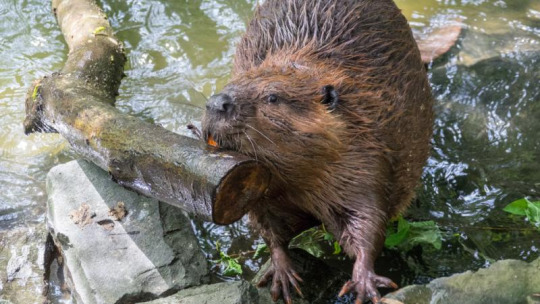
(Image ID: a beaver seen from the front on some rocks by the water's edge. It is dragging a long log in its mouth. Its top incisors are visible and orange. End ID)
The North American beaver is found in most of Canada and the United States, as well as northern Mexico while the Eurasian beaver's natural range has been considerably reduced from what it once was. They now live in portions of western, central, and eastern Europe, west Russia, and Scandinavia, with isolated populations in Mongolia and northwest China. Beavers live in freshwater (and occasionally brackish water) streams and lakes. They are nocturnal and crepuscular, active most commonly between dusk and dawn. Beavers are generalist herbivores, eating a variety of leaves, stems, shoots, roots, and bark. They prefer herby food in summer and woody food in winter. Beavers form stores of food underwater for the winter. Their digestive systems have an enlarged portion of the intestine called a caecum that helps digest the cellulose form all the plants and wood they eat. Their feces has been reported to have sawdust in it. Beavers are territorial and mark their territory with smell using secretions from their anal and castor glands that are placed onto piles of rock and mud they build. beavers defend their territories fiercely and will get into fights with others trying to move into their territory. Beavers who live in neighboring territories will gradually grow less aggressive toward each other and they become used to each other's scent. This is called the dear enemy effect and is seen in other territorial species. Beavers communicate using a variety of noises including whines and growls. A common behavior is slapping the tail against the surface of the water, which is used to alert other beavers to danger.
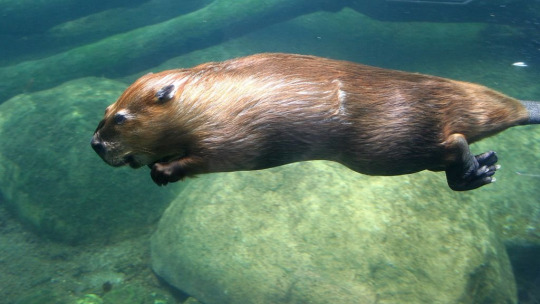
(Image ID: a beaver swimming underwater. Its body is strengthened out and streamlines. Its front legs are tucked under its chin. The hind legs are being used for swimming. The tail is out of frame. There are rocks and logs in the background. End ID)
Beavers require deep and still water to build their homes, but they aren't satisfied just looking for lakes to live in. No, these little entrepreneurs will make the conditions they need by damming streams. I will devote a whole section below to beaver damming and its impacts on the environment. Aside from dams, beavers also build lodges, which are their homes. Building these structures requires material and beavers use wood, mud, and rocks. To get the wood, they use their incisors and powerful teeth to chew through trees and branches. Famously, a beaver can take down a large tree in under a day. Lodges take a while to build, and until it is ready, beavers live in simple burrows on the water's edge. There are two types of lodges: bank lodges and open-water lodges. Bank lodges are burrows along the water's edge covered in sticks and are more common with Eurasian beavers. The more famous open-water lodges are built away from the shore. A pile of sticks forms a platform that is covered with a dome. The dome reaches above the water and is made of sticks and rocks held together with mud. Inside the dome but above the water is an open cavity filled with air. This is called the living space and is (as the name suggests) where the beavers live. The only above-water opening in the living space is an air hole built in the very top. The other entrances are underwater, meaning that beavers can only enter and leave by swimming. This provides good protection from predators, most of whom wouldn't be able to swim into the living space, as wells as insulation to keep the living space warm in winter. Beavers live in familial groups usually consisting of a pair of parents and up to eight children. Family members use the scent of their anal glands to identify each other and will body through grooming each other and play-fighting. The parents are monogamous, but will seek out new mates if they lose theirs. Mating occurs in late December to mid January when the female goes into heat. Up to four pups are born three to four months later. Beavers are born furry and with open eyes and can digest solid food after a week, but usually nurse for up to three months. Beaver milk is more fatty than the milk of other rodents. Beaver offspring will stay with their parents for two years before becoming independent and a family can have two generations of offspring at a time. The largest families need to build multiple lodges. The offspring, called kits, will stay in the lodge for their first one to two months and will start assisting the family with construction of dams and lodges at a year old. They reach sexual maturity between one and three years of age and can live for up to ten years in the wild. Beavers that become independent will travel away from their parent's pond to find a new stream or pond to settle in. This is the time most beavers meet their future mates and the pair will travel together in search of their new home. Beavers will stay in the same territory unless poor conditions force them to leave and find a new home.

(Image ID: A beaver in the Minnesota Zoo with four kits. They are in an artifical lodge with stone walls and star and sticks on the ground. The kits are miniature versions of the adult. End ID.)

(Image ID: an artistic depiction of a beaver lodge with a cutaway to show the interior. It is a large pile of branches with a chamber inside partly submerged in the water. The chamber is connected to the outside by two tunnels the open underwater. There are two adult beavers outside the lodge and three juveniles inside. End ID. Source)
The most famous feature of beaver behavior is their dams. By damming streams, beavers create the large and still ponds they need to build their dams. Beavers that live in pre-existing ponds or lakes that are deep enough for their lodge entrances to be underwater don't need to build dams. To start, thy will dig canals to reduce the flow of the stream, then drive large logs and branches into the mud of the stream bottom to form a base. The dam is then filled in with rocks, branches, shrubs, mud, and anything else the beaver can get its paws on. Beavers can pull or carry objects up to their weight and will build canals and use mud slicks to pull larger logs. Dam complexes can cover acres of territory and the canals beavers dig dig to divert water and help move logs around can be over half a kilometer (1,600 ft) long. The largest dam in the world is in Alberta, Canada's Wood Buffalo National Park and is 775 meters (2,543 ft) long and growing. It was formed of different dams that were combined. Beavers are one of the best examples of ecosystem engineers, species that modify their habitats. They are also a keystone species that are vital in wetland areas of their native range. Dams expand wetlands and reshape the stream environment in ways that typically benefit the local ecosystem. There are some negative impact of beaver dams, including impeding fish migration, increasing silt upstream of the dam, low oxygen levels in the created ponds, and harming species that require fast flowing water. However, the positive impacts of the dams are many and varied. The dams create new ponds that provide habitat for many species that require deeper or slower water, including many aquatic insect larvae, worms, and mussels. These ponds are also ideal spawning locations for many fish and amphibian species, especially salmon and trout that can leap over the dams. Indeed, beaver dams are a huge boon to salmon spawning. The ponds also raise the local water tables and help prevent drought. The areas in and around ponds see a large increase in plant species diversity that encourages local grazing animals and migratory species to visit. Because the areas around beaver ponds are so wet, they act as natural fire breaks, helping mitigate the damage from fires. The dams also help prevent floods downstream by slowing the amount of water that passes, thus helping prevent erosion. The dams act like sieves, filtering out silt, debris, excess nitrogen, and pesticides and other chemicals that get into the water. Bacteria living in the dams break down cellulose in plant matter and release nitrogen gas into the atmosphere. On the downside, beavers have been extending their range north as the arctic warms and their ponds are melting permafrost, which releases methane into the atmosphere.

(Image ID: a beaver in a forest environment gnawing a tree. The tree trunk is slightly thicker around than the beaver. The Beaver is chewing at one side of the tree while the other side is already chewed, resulting in an hourglass shape. End ID)

(Image ID: two beavers sitting on top of their dam and working on building it. One beaver is gnawing on a log while the other one is carrying a bundle of roots in its mouth. End ID)

(Image ID: a beaver dam seen from above. The dam is a large pile of sticks, longs, rocks, and mud that stretches across a stream. The water level on one side of the dam is significantly higher than on the other side. End ID.)
Both species of beaver as currently classified as Least Concern by the IUCN, meaning they are not at risk of extinction. This was not always the case. Beavers have historically been heavily trapped for their meat, fur, and castoreum. The castoreum was used in many forms of medicine. Nowadays it isn't used anymore except in homeopathy and other forms of quackery. The fur trade vastly reduced beaver populations and it was only due to new laws and conservation efforts that the two species were saved from extinction. Since then conservation efforts have largely revolved around trapping beavers and reintroducing them to new areas. Probably the most famous example of this is the 1948 beaver drop, when the Idaho Department of Fish and Game dropped beavers in crates from planes, where they parachuted to the ground and were released. Despite how silly this sounds, it had a much higher survival rate than other relocation methods. Only one of the 76 beavers died due to forcing its way out of the crate during the drop and falling to its death. Beavers can damage infrastructure by damming streams near human activity and can damage trees people want to keep alive. There are ways of mitigating this. Pipes can be used to keep the water levels of the ponds from getting too high and fences or other deterrents around trees keep the beavers from cutting them down. If the beavers are causing too much of a problem, trapping and relocating them can help. On the other hand, sometimes environmental managers trying to attract beavers will make artificial beaver dams to try to entice beavers to adopt a stream. This is sometimes done in streams with too much erosion or water that flows too fast for beavers to settle. The artificial dams start the work and set things up for beavers either relocated to the stream or that pass by and settle down. Beavers are used as symbols of hard work, industry, and families. The beaver is the national animal of Canada. If Canada appreciates the beaver, shouldn't you too?
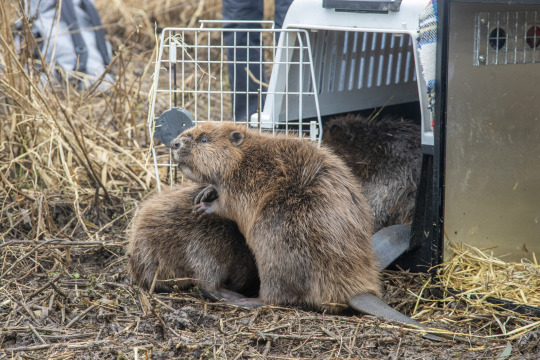
(Image ID: a group of three beavers being released from a crate. End ID)
youtube
(Video ID: archive footage of the 1948 beaver drop. End ID)
#wet beast wednesday#beaver#rodent#mammal#beaver dam#beaver lodge#biology#zoology#ecology#freshwater ecology#animal facts#long post#educational#image described#Youtube
49 notes
·
View notes
Text
The world’s largest beaver dam is not like human dams. It does not stopper a river, or even a stream or rivulet. Its low half-mile barrier collects small trickles that come off a plateau called the Birch Mountains. Along the margin of this comparatively higher ground, it accommodates itself to a slope of less than two percent. The gathered-up trickles have amounted to a lake, and after the beavers eat the plants that grow in it, they may relocate to another dam and another pond, graze that area, then move on again, in a sort of crop rotation. Other dams in this beaver belt are up to three-quarters the length of the longest dam. These long, low dams may help the beavers adapt to drought.

As far as is known, only one person has ever been to the world’s largest beaver dam. In July 2014, Rob Mark, of Maplewood, New Jersey, 44 years old at the time, reached the dam after a challenging journey. Holding the flag of the Explorers Club, the international organization with headquarters in New York City, he took a photo of himself standing on the dam. The top of the structure was the only solid ground he had encountered for miles. After he got back, a newspaper in Edmonton did a story about him, and he appeared in other newspapers and a travel magazine. His achievement is like the dam in that so far no one has said it isn’t unique.
46 notes
·
View notes
Text

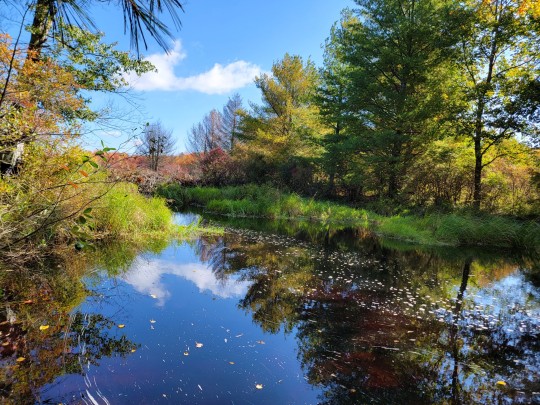
Large Beaver Dam on Two Mile Run - October 1st 2023
#nature#fall#original phography#photographers on tumblr#Pennsylvania#the poconos#beaver dam#front and back of the dam
48 notes
·
View notes
Photo

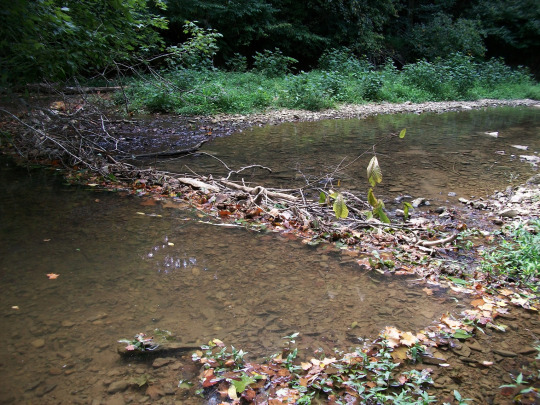
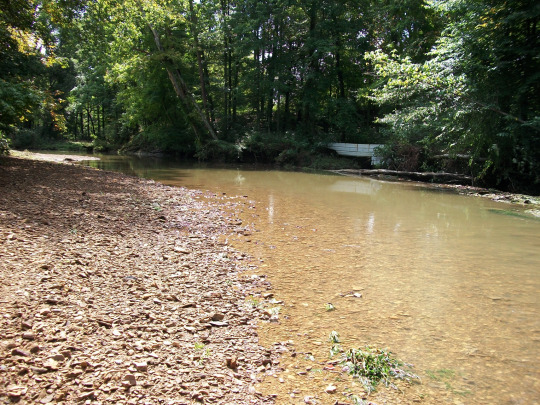
It’s been an exceptionally dry summer around here and the creek hasn’t really flooded much since back in the spring. The local beavers decided to start a dam a couple of months ago—first time I’ve ever seen them do that down there in the nearly twenty years I’ve lived here! Guess the lack of the usual flooding inspired them but recently we had a ton of rain and a BIG flood washed all their hard work away.
202 notes
·
View notes
Photo










Demeure de style ''usonien'' située à Beaver Dam, Wisconsin, création de l'architecte Russell Barr Williamson en 1954. Photo Beau Meyer. - Source MCM Daily.
94 notes
·
View notes
Photo

W Mill Street, Beaver Dam, Wisconsin.
57 notes
·
View notes
Photo


Beaver Dam along Beaver Pond Trail
Photographs taken on June 19, 2023, at Algonquin Provincial Park, Ontario, Canada.
#wildlfowers of southern ontario#Beaver Pond Trail#beaver dam#algonquin provincial park#algonquin#ontario#canada
23 notes
·
View notes
Text
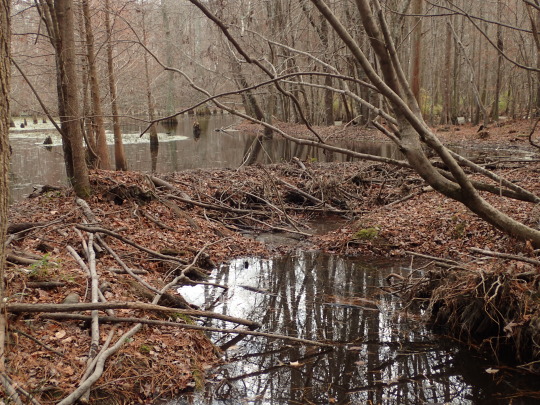
#swamp#trees#beaver dam#photography#photographers on tumblr#original photography#my pics#nature#nature photography#woods#my woods
13 notes
·
View notes
Text

Desolation of a beaver
#beaver dam#wetlands#pond#sorrento#hancock county#maine#original photographers#photographers of tumblr#photo#digital#rodent
19 notes
·
View notes
Text
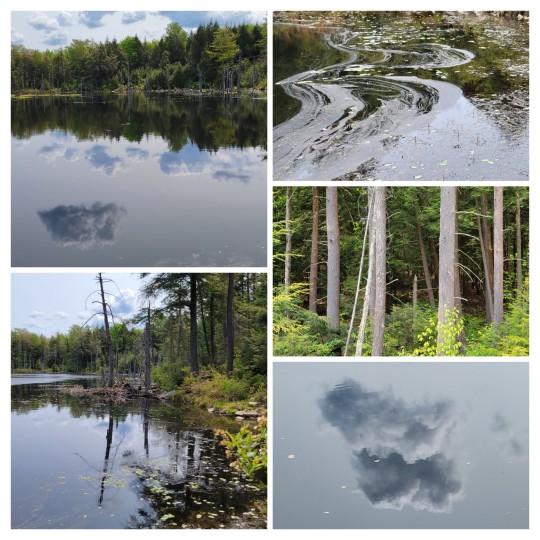
Here now... watching clouds and pond scum slowly drifting by 🌱
#lunaladee photos#clouds#beaver dam#reflections on a lake#pond scum#peaceful#at the cabin#05.22.23#original photography
17 notes
·
View notes
Text
They also noticed that he now had a sort of modest expression on his face – the sort of look people have when you are visiting a garden they've made or reading a story they've written.
"The Chronicles of Narnia: The Lion, the Witch and the Wardrobe" - C. S. Lewis
#book quote#the chronicles of narnia#the lion the witch and the wardrobe#c s lewis#beaver dam#beaver#modesty
6 notes
·
View notes
Text
when people act like Large Beavers are the thing thats wrong with wetlands as if thats not the only thing modifying the natural environment in such a way that the overall ecosystem builds upon the change... ohhhh Those greedy ducks honking away at their Large Beavers. we're literally all trying to reduce erosion and decrease turbidity so we can eat pond weed . Beavers is all we have
13 notes
·
View notes
Text


background elements doodlez
8 notes
·
View notes
Photo

One of the things I love about living in Oregon is that I'll come across random beaver dams in the creeks (soon-to-be ponds) just behind our house!
4 notes
·
View notes
